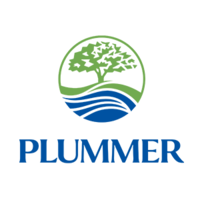Henderson Mill Water Treatment Plant Improvement Evaluation
Overview
At the Henderson Molybdenum Mill in Grand County, Colorado, there have been historic quality and aesthetic concerns with the potable water that made it unsafe to drink and caused the employees to distrust the tap water and depend on bottled water. The Water Girls team was tasked by Plummer Associates, Inc. to improve the design of the potable water treatment system at the Mill for our 2019-2020 Senior Design Project. Along with temperature, taste, and odor, the potable water at the Mill also exceeded EPA and CDPHE guidelines for disinfection-by-products (DBPs). Due to safety concerns, Plummer has already updated the water treatment plant at Henderson to address these issues, however, for this project they provided the team with historical data and site layouts from 2009-2010. In addition to a conceptual design to improve the water treatment plant, the team was tasked to create a community engagement plan to educate the employees on the effectiveness of the current treatment system, with the goal of transitioning employees from bottled water to tap.
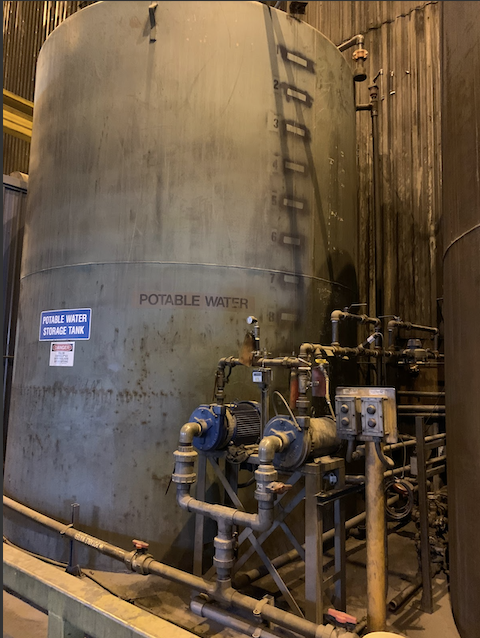
Team Members
- Gillian Allison
- Tori Heckart
- Hannah Herr
- Annie Jiang
- Kate Stephens
- Aurora Waclawski
The Client
- Taylor Baird, PE
Acknowledgements
Project Advisor: Michael Yost, PE
Technical Advisor: Dr. Chris Bellona
The Water Girls team would like to give special thanks to our Project Advisor, Michael Yost, PE, out technical advisor, Dr. Chris Bellona, and most importantly our client, Taylor Baird, PE from Plummer Associates. Without the help and technical advise from these three people this project would not have been possible.
Video
Elevator Pitch
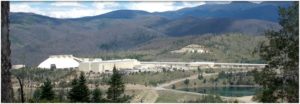 This webpage outlines the design created by the Water Girls team for the Colorado School of Mines 2019-2020 Senior Design course. The design was created for Taylor Baird at Plummer Associates and addresses drinking water quality issues at the Henderson Mill Drinking Water Treatment Plant. This project uses historical data and site layouts from the 2009 water treatment system and tasked the team with improving the water treatment plant system to address employee concerns with the water quality and aesthetic. The design addresses high disinfection byproduct (DBP) concentrations in the distribution system cause by high levels of total organic carbon (TOC) through a treatment train consisting of preliminary screening, ozone contact, microfiltration (MF), media filtration using biologically active filters (BAFs), and chlorine disinfection. The completed design package presented to the client included the proposed system components and supporting calculations, hydraulic calculations throughout the proposed treatment system, an estimation of cost, an evaluation of potential risks, maintenance requirements, future recommendations, and a completed community engagement plan and presentation.
This webpage outlines the design created by the Water Girls team for the Colorado School of Mines 2019-2020 Senior Design course. The design was created for Taylor Baird at Plummer Associates and addresses drinking water quality issues at the Henderson Mill Drinking Water Treatment Plant. This project uses historical data and site layouts from the 2009 water treatment system and tasked the team with improving the water treatment plant system to address employee concerns with the water quality and aesthetic. The design addresses high disinfection byproduct (DBP) concentrations in the distribution system cause by high levels of total organic carbon (TOC) through a treatment train consisting of preliminary screening, ozone contact, microfiltration (MF), media filtration using biologically active filters (BAFs), and chlorine disinfection. The completed design package presented to the client included the proposed system components and supporting calculations, hydraulic calculations throughout the proposed treatment system, an estimation of cost, an evaluation of potential risks, maintenance requirements, future recommendations, and a completed community engagement plan and presentation.
Design Approach
The first step in this design process was to look through the historical water quality data and identify the primary quality concerns. From the data analysis, the team determined that the finished water had high levels of disinfection by-products (DBPs), above national and federal regulatory standards. The team also determined that the raw source water, originating from Ute Creek Reservoir just down the road of the Mill, had high levels of total organic carbon (TOC) that was unsuccessfully removed by the current system and helped contribute to the formation of the DBPs after disinfection with chlorine. This trend in TOC is shown in Figure 1 to the right.
From here, the team started a literature review of potential treatment systems that could successfully target TOC in the water to reduce the formation of DBPs. From this literature review the team came up with three possible treatment trains. The three proposed treatment trains all utilized existing components of the 2009 system including: preliminary screening using bag filters, microfiltration (MF) membranes, and chlorine disinfection. Treatment Option One also included the use of ozone before the MF membranes and biologically active filters (BAF) after the MF membranes. Treatment Option Two consisted of adding a coagulant before the MF membrane to improve the amount of carbon removed through the membrane. Treatment Option Three used chlorine dioxide as a pre-oxidant before the MF membrane and then granular activated carbon (GAC) filter columns. To determine which system would be incorporated into the final design, the team looked at the benefits and drawbacks of each treatment train and created a decision matrix with special attention to the reduction of DBP formation potential and employee safety to decide on which one to move forward with. Other factors of consideration included treatment effectiveness, capital and maintenance costs, footprint, ease of operation, and system longevity. Based on the weighted decision matrix results and discussion with the client, the team decided to move forward with Treatment Option One, shown below in Figure 2 to the right.

Figure 1. TOC Trends From the Source Water, Through the Treatment System, and in Distribution

Figure 2. Simplified Process Flow of Treatment Option One
Design Solution
The concept design created includes preliminary screening with bag filters, ozonation, microfiltration, two biologically activated filter columns, and chlorine disinfection. The bag filters remove various solids from the raw water. Ozonation works to break down the TOC that would otherwise lead to DBPs and the microfiltration membranes and BAF columns remove remaining organics and pollutants. Finally, chlorine disinfection deactivates biological matter that could otherwise cause illness. The ozone and both filtration steps reduce the amount of TOC in the water so the DBP formation potential is greatly decreased. Due to time and material constraints for this project, testing the treatment system with a pilot scale was not feasible, therefore the team had to rely on published data with similar water characteristics to support the anticipated removal rates for TOC in this system. Additionally, the team relied heavily on the technical advice and approval by both the client, Taylor Baird, PE and our technical advisor, Dr. Chris Bellona.
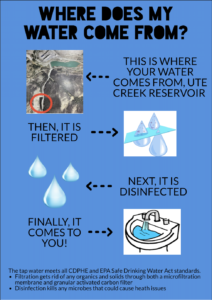
For the community engagement aspect of this project, the team developed a presentation to help inform the employees on the purpose and effectiveness of each component of the current system and why the water is safe to drink. Along with this presentation the team created speaker notes so that anyone at the Mill could give the presentation, as opposed to just members of this design team. Additionally, the team created an educational flyer that is intended to be posted at all major taps at the Mill to further increase awareness and trust of the treated water; a copy of this flyer is shown in Figure 3.
Figure 3. Community Outreach Flyer

Figure 4. Ozone Process Flow Diagram

Figure 5. BAF Process Flow Diagram
Next Steps
Due to the nature of this project, the system design stops with the conceptual model that was created. However, the community engagement presentation and flyer are specific to the current treatment system and not this proposed design. Therefore, those materials are anticipated to be used by the Mill at a later time to help develop trust between employees and the current treatment system. Additionally, the team highly recommends that the Mill replace and relocate their current potable water holding tank. Due to a lack of information, the team was unable to make a specific suggestion on where to relocate the tank, however, moving it from its current location above the boiler should help to greatly reduce the temperature of the tap water and improve taste and odor concerns.
Meet the Team
Gillian Allision
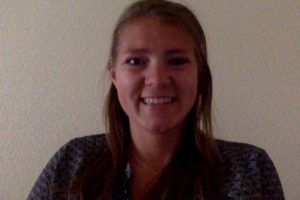 I am a senior in Environmental Engineering from Fort Collins, CO. My main interest in the environmental engineering field is water and wastewater treatment because there are so many things that go into them and both are very important to the community.
I am a senior in Environmental Engineering from Fort Collins, CO. My main interest in the environmental engineering field is water and wastewater treatment because there are so many things that go into them and both are very important to the community.
Tori Heckart
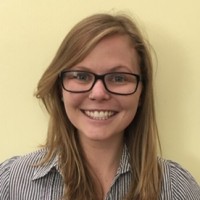 I am a fourth year combined degree student currently pursuing an undergraduate degree in Environmental Engineering and a graduate degree in Civil Engineering. I am originally from Tulsa, OK but grew up in Pleasanton, CA and plan to practice either here in Colorado or internationally. My passion is water treatment and distribution and I hope to use my degree in a career that allows me to provide access to clean and safe drinking water around the world.
I am a fourth year combined degree student currently pursuing an undergraduate degree in Environmental Engineering and a graduate degree in Civil Engineering. I am originally from Tulsa, OK but grew up in Pleasanton, CA and plan to practice either here in Colorado or internationally. My passion is water treatment and distribution and I hope to use my degree in a career that allows me to provide access to clean and safe drinking water around the world.
Hannah Herr
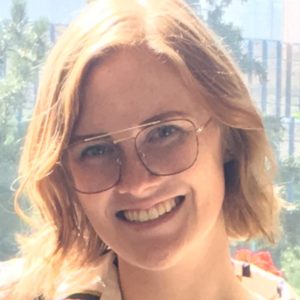 I am a senior environmental engineering student from Pueblo, CO. I would like to use my career in this field to help clean up the environment from catastrophes that occur due to engineering failures every day. I hope I can be apart of many projects that bring the outdoors back to a natural, healthy state.
I am a senior environmental engineering student from Pueblo, CO. I would like to use my career in this field to help clean up the environment from catastrophes that occur due to engineering failures every day. I hope I can be apart of many projects that bring the outdoors back to a natural, healthy state.
Annie Jiang
 I am a senior at Colorado School of Mines pursuing a degree in Environmental Engineering. I am not native to Colorado, but have been living here for more than ten years. I enjoy traveling to experience and see different cultures around the world. My interests is to do water and wastewater treatment process design or related fields. It is very important to have clean water for the communities.
I am a senior at Colorado School of Mines pursuing a degree in Environmental Engineering. I am not native to Colorado, but have been living here for more than ten years. I enjoy traveling to experience and see different cultures around the world. My interests is to do water and wastewater treatment process design or related fields. It is very important to have clean water for the communities.
Kate Stephens
 I am a senior in Environmental Engineering and am most passionate about water and wastewater treatment. During my time at Mines, I held research jobs and was a member of several design and competition teams. I like to spend all of my free time running, rock climbing and hiking in the Rocky Mountains and am motivated to keep our natural resources clean and have found my way to give back to the environment through Water Engineering.
I am a senior in Environmental Engineering and am most passionate about water and wastewater treatment. During my time at Mines, I held research jobs and was a member of several design and competition teams. I like to spend all of my free time running, rock climbing and hiking in the Rocky Mountains and am motivated to keep our natural resources clean and have found my way to give back to the environment through Water Engineering.
Aurora Waclawski
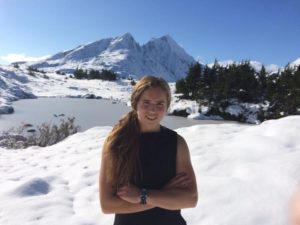 I am a senior in Environmental Engineering with a minor in Leadership in Social Responsibility. My passion is in water and wastewater treatment, especially related to the mining industry. During my time at Mines, I have been able to have jobs doing research, design, and field work. I am originally from Homer, Alaska, so I value the outdoors and the incredible natural resources of Alaska.
I am a senior in Environmental Engineering with a minor in Leadership in Social Responsibility. My passion is in water and wastewater treatment, especially related to the mining industry. During my time at Mines, I have been able to have jobs doing research, design, and field work. I am originally from Homer, Alaska, so I value the outdoors and the incredible natural resources of Alaska.
